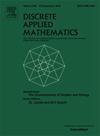Maximum locally irregular induced subgraphs via minimum irregulators
IF 1
3区 数学
Q3 MATHEMATICS, APPLIED
引用次数: 0
Abstract
If a graph is such that no two of its adjacent vertices have the same degree, we say that is locally irregular. In this work we introduce and study the problem of finding a largest locally irregular induced subgraph of a given graph . Equivalently, given a graph , find a subset of with minimum order, such that deleting the vertices of from results in a locally irregular graph; we denote with the order of such a set . We first examine some easy graph families, namely paths, cycles, complete bipartite and complete graphs. However, we show that the decision version of the introduced problem is -Complete, even for restricted families of graphs, such as subcubic planar bipartite, or cubic bipartite graphs. We then show that we cannot even approximate an optimal solution within a ratio of , where and is the order of the graph, unless =, even when the input graph is bipartite.
Then, looking for more positive results, we turn our attention towards computing through the lens of parameterised complexity. In particular, we provide two algorithms that compute , each one considering different parameters. The first one considers the size of the solution and the maximum degree of with running time , while the second one considers the treewidth and of , and has running time . Therefore, we show that the problem is in FPT by both and if the graph has bounded maximum degree .
Since the algorithms we present are not in FPT for graphs with unbounded maximum degree (unless we consider or as the parameter), it is natural to wonder if there exists an algorithm that does not include additional parameters (other than or ) in its dependency. We answer negatively to this question. In particular, we prove that there is no algorithm that computes with dependence or , unless the ETH fails, showing that our algorithms are essentially optimal.
求助全文
约1分钟内获得全文
求助全文
来源期刊

Discrete Applied Mathematics
数学-应用数学
CiteScore
2.30
自引率
9.10%
发文量
422
审稿时长
4.5 months
期刊介绍:
The aim of Discrete Applied Mathematics is to bring together research papers in different areas of algorithmic and applicable discrete mathematics as well as applications of combinatorial mathematics to informatics and various areas of science and technology. Contributions presented to the journal can be research papers, short notes, surveys, and possibly research problems. The "Communications" section will be devoted to the fastest possible publication of recent research results that are checked and recommended for publication by a member of the Editorial Board. The journal will also publish a limited number of book announcements as well as proceedings of conferences. These proceedings will be fully refereed and adhere to the normal standards of the journal.
Potential authors are advised to view the journal and the open calls-for-papers of special issues before submitting their manuscripts. Only high-quality, original work that is within the scope of the journal or the targeted special issue will be considered.
 求助内容:
求助内容: 应助结果提醒方式:
应助结果提醒方式:


